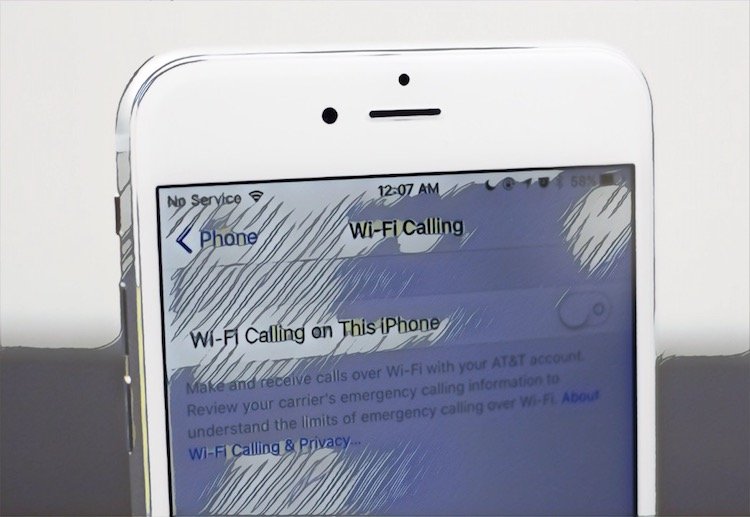Wi-Fi calling is one of the latest features touted by carriers. It’s even the backbone of a few new virtual carriers.
But what is it and why would you want to use it?
We’re about to break down everything you need to know about this new feature--including any pitfalls you might face should you enable it.

So What is Wi-Fi Calling Exactly?
With normal mobile calling, when you place a call, your phone connects to a network’s tower and routes your call to your destination.
This is great when you have a signal, but what if you’re in a building or out in the countryside far from the nearest tower?
If your phone supports Wi-Fi calling, you can enjoy clear calls without worrying about mobile signals.
Wi-Fi calling works just like normal mobile calling but with one important difference--it uses Wi-Fi to connect your call. This means anywhere you have Wi-Fi access, you can forget about worrying about signal quality.
To take advantage of the feature, you’ll likely need one of the newer flagship phones .
However, we expect to see this feature available on more handsets as the technology matures.
Some carriers also offer Wi-Fi calling through apps, but the experience isn’t exactly the same.
That’s Like Skype or WhatsApp Right?
Sort of...
If you’re already using WhatsApp, Facebook Messenger or Google Voice to make calls then those are using Wi-Fi too.
The difference is that you’re not relying on an app or another network to connect your calls or deliver messages. It’s all handled by your phone and carrier.
So Why Bother Using Wi-Fi Calling?
There’s still benefits to enabling Wi-Fi calling on your phone.
The biggest benefit is that Wi-Fi calling works just like normal calling. There’s no need to keep separate apps installed and hop back and forth between them.
You keep your existing phone number and use your phone’s regular dialer.
It should also give you better call quality.
That’s because some carriers support a feature that lets calls jump from Wi-Fi to Mobile and back again as necessary to catch the strongest possible signal. We’ll get into that in more detail shortly.
Wi-Fi calling means you can enjoy a full-strength signal in more places and worry less about missed calls and messages.
No more finding that corner at the coffee shop that gets a signal, avoiding particular rooms of your home when waiting for a call or dropping off the planet on your train commute.
If your carrier doesn’t meter Wi-Fi calls and messages, it might even save you some money!
So How Much Does This Wi-Fi Calling Thing Cost?
In most cases, enabling Wi-Fi calling doesn’t cost anything.
Depending on your carrier, calls and texts might count toward your monthly allotment as if they were placed using the mobile network. Usage with these carriers is billed at the same rate as your normal mobile calls and texts.
If you’re travelling, using your phone over another mobile network can rack up roaming fees quickly. Wi-Fi calling can offer substantial savings here. However, policies differ by carrier. Some carriers at the time of writing don’t offer international roaming over Wi-Fi calling at all.
If this is the case, we recommend picking up a prepaid SIM in the country you’re visiting or using a VoIP app for maximum savings.
Anything Else I Should Consider Before Enabling Wi-Fi Calling?
While Wi-Fi calling sounds great, there are a few things to watch out for...
As of right now, most carriers are using 2G or 3G for voice calls and texts. These older technologies don’t support the network jumping benefits mentioned above. If you leave the range of the wireless network while on a Wi-Fi call, the call might drop.
However, as more carriers adopt VoLTE technology--or use 4G to send voice data and texts--this will be less of a concern.
NOTE: At the time of writing, half of the major carriers and a few smaller ones offer seamless transitioning between mobile and Wi-Fi networks.
Lastly, if you’re on a metered Wi-Fi connection or have a monthly bandwidth cap, your calls and texts using Wi-Fi will count against those as well.
Wi-Fi calling is light on bandwidth usage--carriers estimate about 70MB per hour of voice calling. But multiply this across a whole family using the feature and it might surprise you on your Internet bill.
Also, with some carriers, once you enable Wi-Fi calling, your phone will choose Wi-Fi even when it has a strong mobile signal. For those with tight bandwidth budgets, that might be a reason to reconsider.
If your carrier cannot transition calls between Wi-Fi and mobile networks, this also means calls made from your home would drop should you need to leave while still on the phone. While you could toggle the feature on and off as needed, the complication lessens the benefits offered.
Which Canadian Carriers Support Wi-Fi Calling?
The number of service providers offering Wi-Fi calling has grown rapidly in the past few years. At the time of writing, these are your options for Canadian carriers:

- Only available on unlimited nationwide plans
- No savings on international outbound calls
- Feature not available on Wi-Fi Networks outside Canada
- SMS/MMS included with plans
- No call transfers

- Only available on iPhone SE or iPhone 6 and newer
- Calls and messages count toward your monthly limits
- No savings on international outbound calls
- Feature not available on Wi-Fi Networks outside Canada
- Calls transfer in areas with VoLTE coverage

- Calls and messages count toward your monthly limits
- No savings on international outbound calls
- No roaming fees on calls received while on Wi-Fi outside Canada
- No roaming fees on calls or messages to Canada while on Wi-Fi outside Canada
- All other roaming charges will match the roaming features on your plan
- Calls transfer in areas with VoLTE coverage

- Calls and messages count toward your monthly limits
- No savings on international outbound calls
- No roaming fees on calls received while on Wi-Fi outside Canada
- No roaming fees on calls or messages to Canada while on Wi-Fi outside Canada
- All other roaming charges will match the roaming features on your plan
- Calls transfer in areas with VoLTE coverage

- Calls and messages count toward your monthly limits
- No savings on international outbound calls
- No roaming fees on calls received while on Wi-Fi outside Canada
- No roaming fees on calls or messages to Canada while on Wi-Fi outside Canada
- All other roaming charges will match the roaming features on your plan
- Calls transfer in areas with VoLTE coverage

- Currently only available on select Apple, LG, and Samsung phone models.
- Feature not available on prepaid Koodo accounts.
- No savings on international outbound calls
- Feature not available on Wi-Fi Networks outside Canada
- SMS/MMS included with plans
- Calls transfer in areas with VoLTE coverage

- Available on phones supporting Wi-Fi calling
- Calls and messages count toward your monthly allotment of minutes and messages
- No long-distance fees when calling numbers within the same country in more than 50 countries
- International rates from Canada to other countries starting at $0.77 per minute
- SMS/MMS included with plans
- No calls transfer

- Only available on unlmited Canada-wide Platinum Plans
- No savings on international outbound calls
- Feature not available on Wi-Fi Networks outside Canada
- SMS/MMS included with plans
- No calls transfer
TIP: Wi-Fi calling is not legal in all countries. In areas where it is not legal, using VPNs or other tricks to enable Wi-Fi calling on your phone may be a criminal offense. Be sure to research regulations prior to using Wi-Fi calling when travelling the world.
Getting Started with Wi-Fi Calling
Most flagship phones from the past two generations support Wi-Fi calling.
Popular phones that support Wi-Fi calling include:
NOTE: In some cases, you’ll need a carrier-branded phone to activate the feature even if the phone itself supports it. Before purchasing a new phone to use Wi-Fi Calling, check with your carrier to be sure it will work.
Instructions to activate Wi-Fi calling will differ depending on the manufacturer and model of your phone.
For iPhones:
Tap Settings
For more information on enabling Wi-Fi calling on your iPhone, consult Apple’s Wi-Fi Calling support page .
For Android phones:
Open your App Drawer
Tap Settings
Tap Connections
Tap More Networks
Toggle Wi-Fi Calling to Enabled
For more information on enabling Wi-Fi calling on your Android device, contact your carrier .
If you’ve enabled the feature on your phone and still can’t place calls over Wi-Fi, you might need to contact your carrier or visit your account portal online to enable the feature there as well.
Your Turn
As Wi-Fi calling continues to gain popularity, we expect better support for devices.
Who knows--maybe in a few years, you won’t need to worry about mobile signals at all!
If you’ve had a good experience with Wi-Fi calling or this guide helped you get started, let us know!
Have a bad experience or concern? We want to hear about that too! Just drop us a line in the comments below!
P.S. The more Wi-Fi networks you discover, the more use you can get out of Wi-Fi calling. Our guide on finding free Wi-Fi includes tips on both hunting down the best hotspots nearby and best practices to increase security and keep your personal information safe on public Wi-Fi networks.








